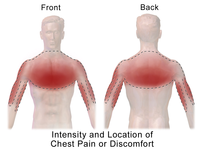
Photo from wikipedia
OBJECTIVES The electrocardiograph (ECG) is an essential tool in initial management and risk stratification of patients with suspected acute coronary syndrome (ACS). A six-point reporting criterion has been proposed to… Click to show full abstract
OBJECTIVES The electrocardiograph (ECG) is an essential tool in initial management and risk stratification of patients with suspected acute coronary syndrome (ACS). A six-point reporting criterion has been proposed to facilitate standardized clinical assessment of patients presenting to the emergency department (ED) with suspected ACS. We set out to evaluate the efficacy of these criteria in identifying patients with major adverse cardiac events (MACE), Type 1 myocardial infarction (T1MI), Type 2 myocardial infarction (T2MI), and 1-year mortality in a cohort of emergency patients with chest pain. METHODS This was an analysis of data from 2,349 patients who presented to the ED with chest pain between 2008 and 2013. Data were collected as part of two prospective trials. ECGs were recorded at presentation and categorized according to the six-point criteria by local cardiologists blinded to all clinical information. The primary outcome was 30-day MACE, including T1MI, T2MI, unstable angina pectoris, revascularization, and 30-day mortality. The outcome was adjudicated by cardiologists on the basis of all clinical information and test results. Likelihood ratios and odds ratios for 30-day MACE were reported for each ECG category. RESULTS Major adverse cardiac events were diagnosed in 264 (11.3%) patients. Increasing ischemic abnormalities in ECGs, as categorized by the standardized reporting criteria, were associated with increasing rates of MACE. Within 30 days, T1MI occurred in 148 (6.3%) patients and T2MI occurred in 59 (2.5%) patients. Risk for T1MI increased with higher classification of ECG abnormalities. T2MI rates were highest in patients with ECGs of nonspecific changes. CONCLUSIONS The rates of MACE, T1MI, and 1-year death can be stratified according to standardized ECG criteria in patients presenting to the ED with chest pain. The ECG findings in patients with T2MI are variable, and the ECG is less helpful in defining risk in this group.
Journal Title: Academic Emergency Medicine
Year Published: 2017
Link to full text (if available)
Share on Social Media: Sign Up to like & get
recommendations!